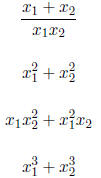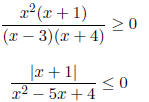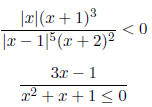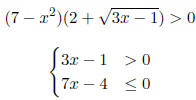Notes - Week 3
1. Let p and q be prime numbers. It is known that both
roots of
x2 + px + q
are integers. Find p and q .
2. Find a quadratic polynomial whose roots are the reciprocals of the roots of
5x2 - 7x - 13.
3. Consider the quadratic equation
x2 + 4x + 1 = 0.
Without computing its roots  and
and
 find
find
|
(a) |
 |
|
(b) |
|
(c) |
|
(d) |
4. Derive Vieta's formulas for the cubic polynomial
ax3 + bx2 + cx + d.
Solving Inequalities
Let's look at another problem related to finding roots of a quadratic equation.
Example 1. Investigate the signs of the roots of the quadratic equation
(a - 4)x2 - 2ax + a + 4 = 0
depending on the value of the parameter a.
First of all we need to understand how many roots that equation has depending
on the value of a. For this we find its discriminant

Hence the quadratic equation has two roots for every a. We have to be careful
here. When a = 4 the coefficient of x 2 is zero and the equation is not quadratics
anymore. In this case it has just one root x = 1 (check!) When a ≠ 4 using the
quadratic formula we find

Hence one of the roots is always positive. Let's see when
the second root is
positive.

To solve this inequality we use the intervals method which
we will discuss in detail
later. We plot a = 4 and a = -4 on the number line with empty dots "o"
(idicating that these points do not satisfy the ineqaulity) and figure out the
signs
of (a + 4)/(a - 4) on the obtained intervals.

Hence the second root is positive if a ∈ (-∞,-4) ∪ (4,∞).
Similarly, the second
root is negative if a ∈ (-4, 4).
We now know what is going on for each value of a except a = -4. In this case
the product of roots is zero and hence one of the roots is zero while the other
is
1.Answer:
a ∈ (-∞,-4) ∪ (4,∞) two positive roots
a ∈ (-4, 4) one root is positive, another is negative
a = 4 unique root, positive
a = -4 one root is zero, another is positive
Inequalities occur in numerous other contexts. We now turn to various tech-
niques of solving inequalities. Inequalities in one variable x are of the form
f(x) > g(x), f(x) < g(x), f(x) ≥ g(x), f(x) ≤ g(x):
To solve an inequality means to find its solution set , all the values of the
variable
x which satisfy the inequality. Two inequalities are equivalent if they hold for
the
same values of x, that is, if their solution sets coincide. In the process of
solving
an inequality we are trying to reduce it to a simpler equivalent inequality.
Recall
that " " means "equivalent".
" means "equivalent".
Here are three basic rules for handling inequalities. The sign ">" below can be
replaced with "<", "≥ ", or "≤ ".
Rules for Handling Inequalities
•
We can add any constant a to both sides of an inequality.
f(x) > g(x)  f(x) + a > g(x) + a
f(x) + a > g(x) + a
•
We can multiple both sides of an inequality by a positive number a.
if a > 0, f(x) > g(x)  af(x) > ag(x)
af(x) > ag(x)
•If we multiply both sides of an inequality by a negative
number a, the in-
equality switches:
if a < 0, f(x) > g(x)  af(x) < ag(x)
af(x) < ag(x)
We will often use these rules to reduce our inequality to the simplest form and
will the use the intervals method to solve the obtained inequality.
Intervals Method
This method is used to solve inequalities of the form

Here the sign ">" could be replaced with "<",
" ≥ ", or " ≤ ".
(a) Find the points where f(x) or g(x) are either zero or change sign . If f(x)
and
g(x) are polynomials, those points are the roots of f(x) = 0 and g(x) = 0.
Mark those points on the number line with a filled dot " • " if the point satisfies
the inequality and with an empty dot " o " otherwise.
(b) For each of the obtained intervals figure out the sign of f(x)/g(x) and write
that sign next to the interval. Shade the values that satisfy the inequality.
Example 2. Solve the inequality

It is tempting to multiply both parts by x2 - 5x + 6
here. Notice that if we do
this we have to consider cases when x2 - 5x + 6 > 0 and x2
- 5x + 6 < 0 so
that
we know if the inequality switches sign or not. This is doable, but let's
instead
subtract 1/2 from both sides and clear the denominators:

We are now ready to use the intervals method. Notice that
the roots of the
numerator x = 1 and x = 4 are marked with filled dots " • " as they satisfy the
inequality.

Answer: (-∞, ∞] ∪ (2, 3) ∪ [4,∞)
Notice how the signs alternate in the picture above. This is always the case if
both f(x) and g(x) in the inequality f(x)/g(x) > 0 are polynomials that do not
contain factors of the form (x-a)2n (the degree is even). If either in f(x) or
g(x)
we have such a factor the sign of f(x)/g(x) does not change as we pass from one
side of x = a to the other.
Example 3. Solve the inequality

Here is the picture we get.

Notice that the sign does not change at x = 3 and x = 1 as
the corresponding
terms 2x - 6 and x - 1 appear in the inequality in even degrees (4 and 2).
Answer: (-∞,-4) ∪ (0, 3/2]
Example 4. Solve the inequality
2x2 + 3x + 4 ≥ 0
This quadratic function has negative discriminant and hence has no x- intercepts .
The graph is a parabola that opens upward, hence the function is always
positive.
Answer: (-∞,∞)
Example 5. Solve the inequality
3x2 - 4x + 2 < 0
This quadratic function has negative discriminant and hence has no
x-intercepts. The
graph is a parabola that opens upward, hence the function is never negative.
Answer: 
Solve the inequalities.
|
1. |
 |
|
2. |
|
3. |
 |
|
4. |
Find the domain.
|
5. |
 |
|
6. |
Solve the inequalities.
|
7. |
 |
|
8. |



